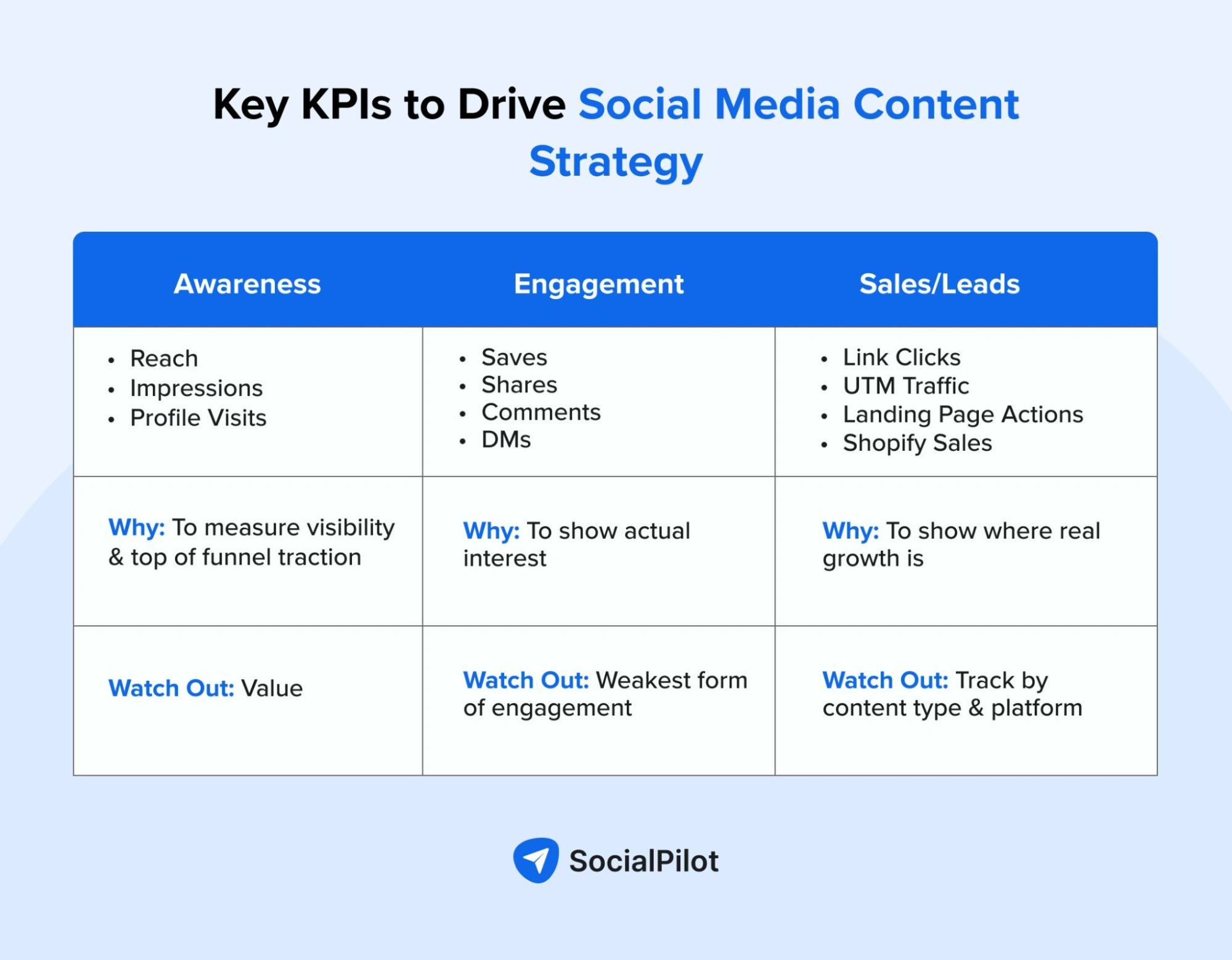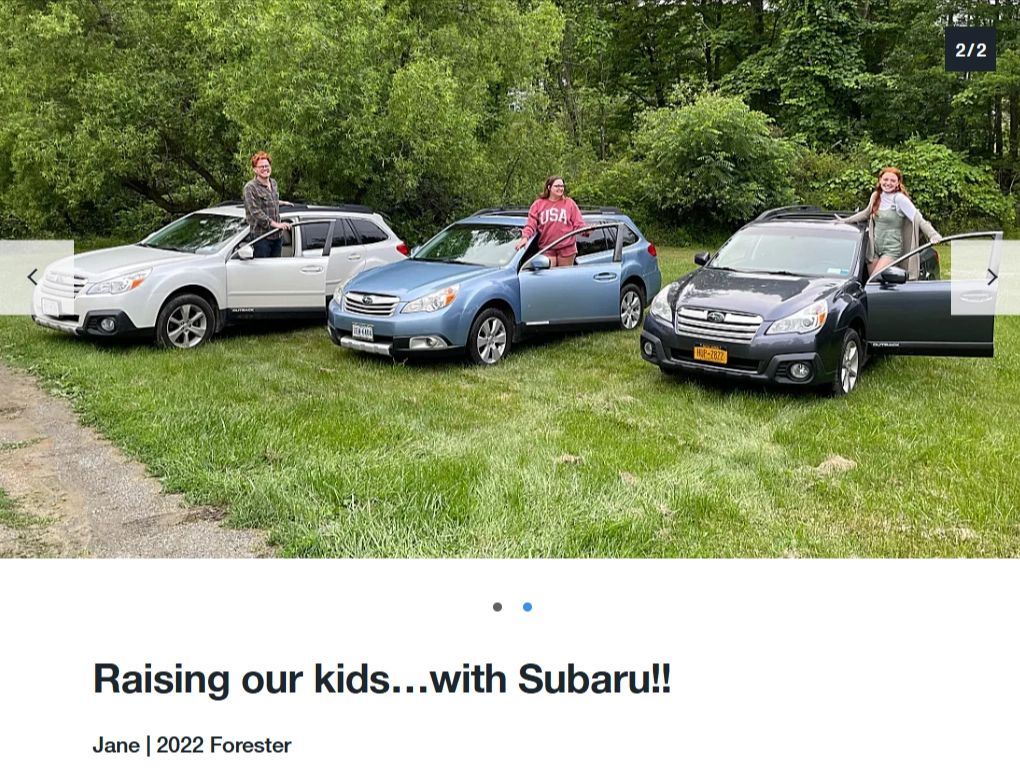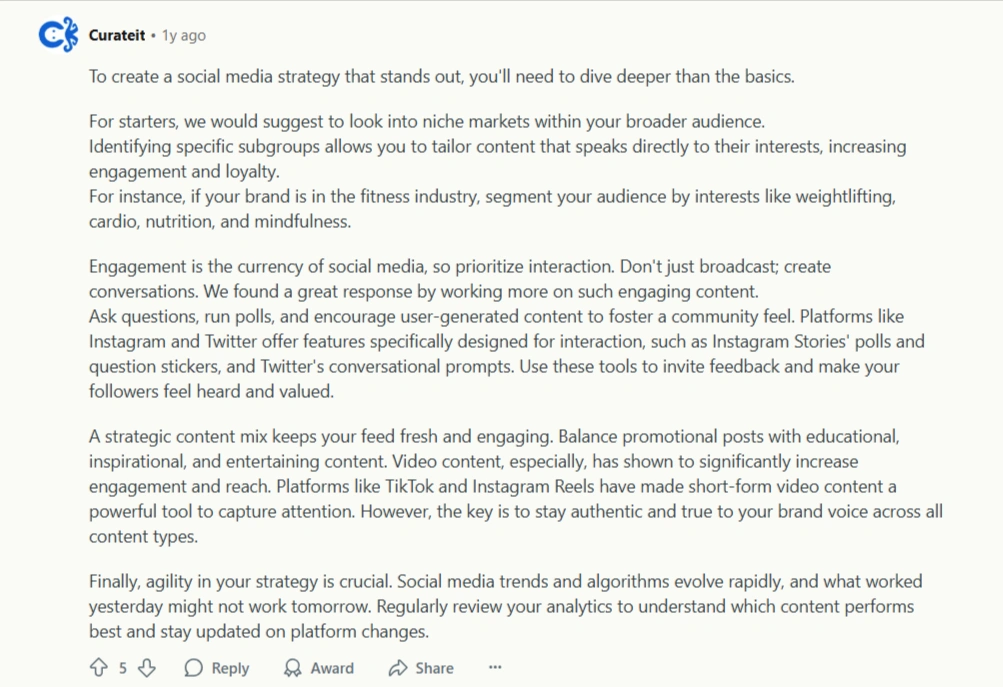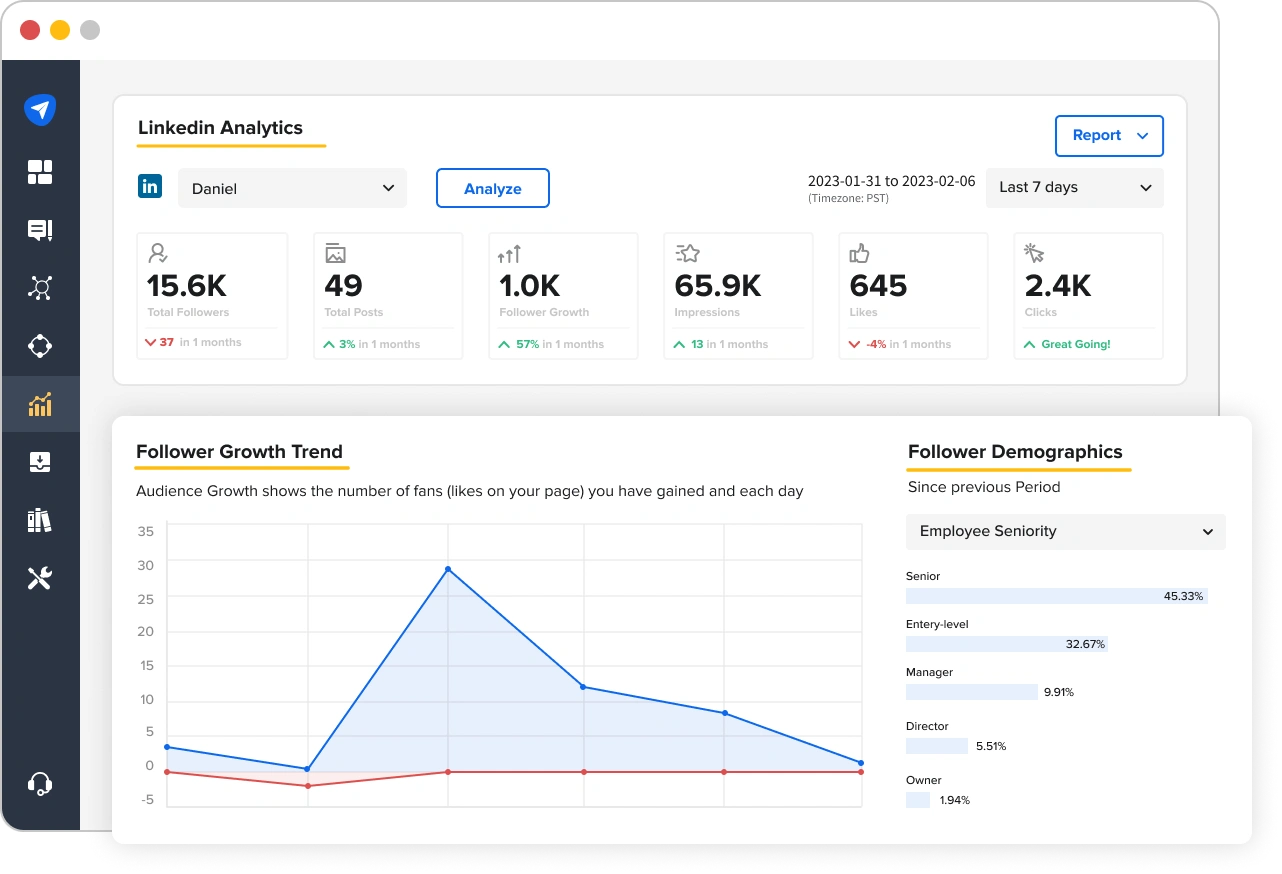As of February 2025, 5.24 billion people—nearly 64% of the global population—are active on social media. That’s not just reach. That’s an opportunity.
And yet, most brands are still stuck in survival mode—posting without purpose, chasing trends without clarity, and burning time on platforms that don’t convert. For growing businesses and busy marketing agencies, it’s easy to fall into a loop of “just get something out there.”
But here’s the truth: showing up isn’t enough anymore. You need a content strategy that’s sharp, scalable, and rooted in results.
This blog is your roadmap to building a high-performing social media content strategy in 2025—one that aligns with your marketing goals, speaks directly to your audience, and makes every post count.
Before we break it down step by step, here’s a quick snapshot of what a winning content strategy actually looks like in 2025:
At a Glance: What Makes a Social Media Content Strategy Work in 2025?
- It’s structured – Not “what should we post today?” chaos.
- It’s goal-driven – Every post ties back to business KPIs.
- It’s audience-first – Built on segmentation, not assumptions.
- It’s format-flexible – Reels, TikToks, carousels, memes—what works gets posted.
- It’s consistent – Planned, scheduled, measured. No burnout.
- It’s powered by tools – Like SocialPilot for planning, publishing, and performance.
TL;DR?
A solid content strategy helps you post smarter, show up consistently, and actually move the needle.
Let’s cut through the chase—most “strategies” floating around on the internet are either repackaged templates or a random list of content ideas that doesn’t work.
What you need is a strategy built like a system that aligns with your marketing objectives, adapts to platform shifts, and gives you repeatable wins without burning out your team.
Let’s break it down.
1. Set Content Goals to Drive Growth
If your social content doesn’t tie directly to marketing KPIs, it’s just noise.
High-performing strategies reverse-engineer content from real marketing outcomes—whether that’s getting demo signups, boosting add-to-cart rates, or generating qualified leads. Social isn’t the sideshow anymore. It’s a frontline growth engine.
Why Does This Matter?
Agencies and SMBs don’t have the luxury of throwing content at the wall and hoping something sticks. You’re managing limited resources and tight timelines. Clear, measurable goals help you focus your efforts, justify results to clients or execs, and avoid the burnout of posting for the sake of visibility alone.
How to Align Social Goals with Marketing KPIs?
Examples of Smart Goals for 2025
To avoid vague fluff like “grow our Instagram,” your goals should be: Specific, Measurable, Achievable, Relevant, and Time-bound. Like:
- Increase Instagram Story link clicks by 25% in (content)
- Boost X (Twitter) engagement rate from 1.2% to 2% by (content)
- Drive 300 qualified leads from LinkedIn carousel ads in 60 days
- Generate $5,000 in revenue from Facebook Shop posts this month
Each of these connects content with a clear business result and that’s how you prove social ROI.
Now that you’ve set your SMART goals, it’s time to define the key performance indicators (KPIs) that will help you track real progress.
Pick KPIs That Prove Progress
Let’s be clear: not all KPIs deserve your energy. Focus on the ones that tie to intent and action.


Once your goals are locked in, your next move is to understand who you’re creating for. Because a goal without audience insight? That’s just a guess.
2. Understand Who You’re Creating Content For
If you’re still relying on assumptions about what your audience wants based on age or location, your content will miss the mark. Winning strategies in 2025 are built on how people interact, why they engage, and what triggers action.


Why Does This Matter?
For small in-house teams and agencies managing multiple brands, guessing wastes time and time is budget. Deep audience understanding helps you create content faster, test smarter, and convert more. And when every post hits closer to the pain point, your ROI goes way up.
How to Go Beyond Demographics?
- Start with behavior-based insights: Track when they post, what they share, what format they save. Are they poll-takers? DM responders? Link clickers?
- Look at common friction points: Are they overwhelmed by options? Skeptical of pricing? Short on time? Your content should solve, not sell.
- Create audience “moodboards”: Collect the content your audience already engages with—styles, tones, formats. It tells you what feels native to them.
- Avoid assumptions: Just because they follow you doesn’t mean they want what you’re posting. Ask, test, adapt.
Of course, this level of audience insight doesn’t come randomly. You’ll need tools to uncover the real data behind the behaviors. Here’s where to start.
Tools to Use
Behavioral insights are only as good as the tools that power them and the right toolkit helps you move from assumptions to audience intelligence—fast.
- GA4 (Google Analytics 4): Dive into user journeys, interests, and referral sources. Create segments like “returning social traffic” and see what makes them stick.
- Meta Insights (for Instagram & Facebook): Identify peak activity times, top-performing content, and what drives profile actions.
- Polls, Q&As, and Surveys: Ask directly—on Stories, via email, or even post-purchase. One simple question like “What do you want more of?” can shape your content calendar.
- Reviews & Testimonials: Goldmine alert: This is real language from real people. Use their phrasing to build trust-driving copy.
Now that you’ve got the tools to understand your audience, let’s talk about how to activate that insight. The secret? Smart segmentation that turns broad messaging into personal relevance.
Segmentation by Interests for Better Engagement
Here’s the secret sauce: specificity builds connection. The more your content speaks to a subset of your audience, the more likely it is to feel personal—and get shared.
- Instead of “fitness tips,” try “30-minute workouts for busy moms”
- Instead of “marketing advice,” try “B2B LinkedIn growth tips for consultants”
- Instead of “budgeting help,” try “cash flow hacks for solopreneurs”
Tip:One smart tactic? Break your content calendar into mini-series by niche (e.g., Mindful Monday for wellness, Tactical Tuesday for paid ads). It creates rhythm and relevance your audience looks forward to.
Example: Subaru understands the power of authentic storytelling and segmentation with their ongoing Dear subaru campaign. Instead of polished ads, they invite real customers to submit heartfelt stories, videos, and photos of their Subaru journeys.


From cross-country adventures to daily commutes, the content is raw, emotional, and 100% user-driven. This UGC strategy not only humanizes the brand but also reinforces its values—safety, longevity, and lifestyle alignment—through the voices of its loyal community.
Knowing your audience helps you show up where it counts. Now let’s focus on picking the right platforms—because being everywhere is not the same as being effective.
3. Choose Platforms That Fit Your Content Style
Being “everywhere” is not a strategy—it’s a surefire way to burn out and dilute your message. In 2025, high-performing brands are mastering “platform prioritization.” That means showing up where their audience already spends time and creating content that feels native to each platform.
Why Does This Matter?
Whether you’re managing three brands or scaling your own, spreading yourself too thin kills consistency and creativity. Choosing the right 2–3 platforms for your content type helps you go deep and that’s where real growth happens.
You understand why focus matters—but how do you actually choose the right platforms? It starts with knowing where your audience already spends their time.
How to Find Where Your Audience Is Most Active?
- Use platform-specific insights: Instagram, Facebook, LinkedIn, and TikTok all offer native data on audience behavior. Look at engagement and action—where are they clicking, sharing, saving?
- Check your referral traffic in GA4: Which platforms are driving real business outcomes—like visits, signups, or purchases?
- Spy on competitors: What platforms are your competitors investing in heavily? If they’re consistently active and getting interaction, there’s a reason.
- Ask your audience: A simple Story poll—“Where do you prefer to follow us?”—can be eye-opening.
Identifying the right platforms is step one. Step two? Speak the native language of each one. Your content format should feel built for the feed—not pasted across channels.
Channel-Content Fit Table
| Platform | Best For | Avoid Posting |
| Reels, UGC, tips in carousel form | Long static text | |
| Events, lives, personal storytelling | Meme-dumps | |
| Case studies, leadership POVs | Instagram-style Reels | |
| TikTok | Trends, how-tos, storytelling | Formal promos |
| Twitter/X | Commentary, quick engagement, news-jacks | Overly curated posts |
| Product roundups, visuals, blog graphics | Text-only Content | |
| YouTube | Tutorials, explainers, vlogs, reviews | Super short clips without substance |
| Threads | Casual brand takes, relatable micro-stories | Corporate press releases |
| Snapchat | Ephemeral content, offers, filters | Static or recycled content |
| Google Business | Offers, hours, local news | Non-local content |
| WhatsApp Business | Customer service, personal updates, promotions | One-size-fits-all broadcast messages |
How Many Platforms Should You Really Be On?
The magic number for most SMBs and agencies? Two to three. That’s it.
Any more, and you’re repurposing without relevance—or worse, ghosting audiences.
- Start with your highest-converting platform
- Add a second for reach or community
- Use a third only if you’ve got the bandwidth
If you’re serious about growing across multiple platforms without losing your mind, SocialPilot gives you the infrastructure to plan smarter, post faster, and grow consistently.
Here’s how it powers every part of your content strategy:
- Plan & Publish Seamlessly – Schedule across platforms using Smart Scheduler, Bulk Upload, and a drag-and-drop Content Calendar.
- Create High-Performing Content Faster – Generate captions, hashtags, and post ideas with AI Pilot.
- Collaborate Like a Pro – Assign roles, manage permissions, and approve content on the go.
- Measure What Matters – Track post performance, audience behavior, and hashtag ROI with easy-to-read analytics and white-label client reports.
- Engage From One Unified Inbox – Manage all your DMs, comments, and reviews across platforms in one unified social inbox.
Start Your 14 Day Free Trial
Tailor Your Content Strategy by Industry
Every industry has a different rhythm, tone, and content appetite. Here’s a cheat sheet to help you align your content strategy with what performs best in your niche:
| Industry | Best Platforms | Content Formats | Tips for Strategy |
| eCommerce | Instagram, TikTok, Pinterest | Product demos, UGC, influencer collabs, tutorials | Leverage trends + short-form to drive clicks and purchases |
| SaaS/B2B | LinkedIn, YouTube, X | Thought leadership, case studies, explainers | Use carousels, long-form videos, and client spotlights |
| Coaches/Consultants | Instagram, LinkedIn, YouTube Shorts | Tips, how-to Reels, storytelling | Share mindset content, client success, and motivational posts |
| Hospitality/Travel | Instagram, Facebook, YouTube | Visual storytelling, guides, location tags | Focus on aspirational visuals and user reviews |
| Health & Wellness | Instagram, Pinterest, Facebook | Infographics, routines, before-after content | Build authority through educational and inspirational posts |
| Real Estate | Facebook, Instagram, YouTube | Property tours, Reels, virtual walk-throughs | Use local hashtags, story highlights, and client UGC |
| Education/EdTech | YouTube, LinkedIn, Facebook | Explainers, webinars, tips for students/teachers | Repurpose webinar clips and focus on “value-first” messaging |
As a social media manager, use this chart to segment your calendars by industry. Planning by niche makes your strategy more relevant—and more effective.
By now, you’ve picked the platforms that best suit your brand voice and audience. Ready to pull everything together into one streamlined content strategy?
Use our Free Social Media Strategy Template to:
- Outline your content goals and target KPIs
- Break down platform-specific strategies
- Plan what to post, where, and when
- Track your results and improve each cycle


4. Plan Content That Educates, Entertains, Inspires, and Sells
Not every post needs to promote—but every post needs to serve a purpose. In 2025, the best brands don’t just post—they educate, entertain, inspire, and sell in a content rhythm that feels natural, not salesy.
Why Does This Matter?
Most brands fall into one of two traps: being overly promotional or overly generic. A structured content strategy keeps your feed balanced, your brand voice consistent, and your content mapped to your audience’s emotional and informational needs.
This approach also helps you:
- Plan content faster with less mental fatigue
- Avoid repeating the same themes week after week
- Match content intent with business goals (awareness, engagement, conversion)
Still struggling with content ideation & creation? Need a wingman? Try our AI Pilot to:
- Generate scroll-stopping post ideas
- Rewrite & Optimize content for every platform
- Match your posts to audience intent
Stay Consistent. Stay Creative.


How to Use the 4-Pillar Content Framework?
Use this core framework to give your content purpose, variety, and structure:
| Content Pillar | What to Post? | Why it Works? | Goal it Supports |
| Educate |
How-tos, tips, tutorials, explainers Example: “5 Things to Fix in Your IG Bio Today” |
Positions your brand as helpful & credible | Awareness + Trust |
| Entertain |
Memes, trends, humorous takes, challenges Example: “Monday Mood Memes for Agency Life” |
Makes your brand relatable and boosts shares | Reach + Engagement |
| Inspire |
Success stories, testimonials, mindset tips Example: “From 0 to 10K Followers—How One Creator Stayed Consistent” |
Builds emotional connection, drives loyalty | Affinity + Retention |
| Promote |
Product demos, service features, limited-time offers Example: “Here’s How This Tool Saved 6 Hours/Week For A Small Biz Owner” |
Drives action with clear CTAs | Leads + Sales |
Tip:Add a content tag to each post in your calendar—“E”, “En”, “I”, or “P”—to visually balance your weekly content split at a glance.
Example: Winning Approach to Content Strategy
Here’s how CurateIt—an AI-powered content curation platform—nailed their strategy on Reddit by leaning into audience segmentation, authenticity, and interaction-first content.


Key Takeaways for Social Media Managers:
- Niche down, then show up – Instead of targeting a broad “fitness audience,” they are segmented by specific interests like weightlifting, cardio, nutrition, and mindfulness for hyper-relevant engagement.
- Create conversations, not broadcasts – Saw major lift by asking questions, running polls, and encouraging UGC—using features like IG Story stickers and Twitter prompts to spark two-way interaction.
- Balance the content mix – Focused on a healthy ratio of educational, entertaining, inspirational, and promotional content to keep their feed dynamic and valuable.
- Lean into short-form video – Leveraged Reels and TikToks to boost visibility, while staying authentic to their voice across formats.
- Adapt with analytics – Stayed agile by reviewing content performance regularly and tweaking their strategy based on what actually resonated.
Use a Weekly Split to Keep A Balance
A strong content strategy doesn’t just focus on what to post but how often to post what. The wrong ratio can turn your feed into a sales pitch, or worse, a scroll-past zone.
To stay engaging and trustworthy, we recommend a simple, proven cadence:
- 3 Value Posts – Share content that educates, entertains, or inspires. These posts build trust, deliver utility, and keep followers coming back.
- 2 Promotional Posts – Promote your product, offer, service, or success stories. Keep it clear, persuasive, and CTA-driven—but not overwhelming.
This 3:2 ratio keeps your audience engaged while still supporting your business goals. And with SocialPilot’s Content Calendar, you can easily map out this balance, drag posts around, and make sure your feed always feels intentional and not rushed.
Example: Shein tapped into TikTok’s algorithmic strength by creating hyper-personalized product videos tailored to user behavior. These weren’t just hauls—they were smart, data-backed content drops.
The payoff? 45% higher click-through rates and 4.5x higher purchase intent compared to generic videos. Their strategy proves that personalized short-form content not only captures attention but converts curiosity into action.
A solid content plan is just the start—now let’s dial in the formats that stop thumbs and drive real engagement.
5. Use Winning Formats for Maximum Engagement
In 2025, the right format doesn’t just boost views; it stops thumbs, sparks shares, and drives action. This section covers the formats that consistently outperform.
Why Does This Matter?
Posting without a format strategy is like broadcasting in the dark. For social media managers juggling multiple brands or client accounts, it’s not enough to chase views. You need each format to:
- Serve a purpose in the content funnel
- Match the audience’s scroll behavior
- Deliver content in a way the platform prefers
That’s how format becomes a lever, not just a layout
Viral-Ready Content Format Guide
Short-form videos are non-negotiable for reach and engagement across almost every platform. Here’s how to do it right:
| Platform | Best Length | Must-Have Elements | Best For | Key Content Strategy Use |
| Instagram Reels | 60-90 seconds | Trending audio, captions, bold intro in 2s | Awareness, Engagement | Hook audience with how-tos, myth-busting, or brand moments |
| TikTok | 15-60 seconds | Visual hook, real faces, viral formats | Awareness, UGC, Community | Leverage POVs, trends, and raw storytelling for relatability |
| YouTube Shorts | 15-30 seconds | Strong CTA, clean visuals, searchable hashtags | Value Delivery, Discoverability | Fast tutorials, listicles, teasers that lead to long-form content |
| Facebook Reels | 03-90 seconds | Subtitles, native trends, authentic tone | Retargeting, Brand Warmth | Repurpose high-performing Reels and motivational clips |
| 45 seconds – 2 minutes | Thought leadership hook, professional tone | Trust, Thought Leadership | Share lessons, advice, and cultural moments from a pro lens |


Here’s a catch: viral formats may get the views, but authenticity gets the trust. If your content doesn’t feel real, it won’t stick. Let’s talk about how to make it resonate.
How to Make It Authentic?
Your audience wants real. This year, content that feels human wins every time. Here’s how to craft it:
- Let your fans speak for you: User-generated content (UGC) builds instant trust. Feature customer shoutouts, tag reposts, and community reactions to show you’re not just broadcasting—you’re listening.
- Drop memes, not sales pitches: A timely meme does more than entertain—it connects. When your audience sees themselves in your content, they pause, laugh, and share. That’s cultural relevance on autopilot.
- Partner with creators, not just influencers: Micro-influencers bring niche credibility and tight-knit followers. Look for creators whose vibe matches your brand—not just their follower count.
- Think native, not recycled: Platform-first content respects the rules of the feed: vertical formats, trending audios, raw edits, and captions that don’t scream “ad.” Keep it real, and the algorithm will reward you.
Example: Clinique doubled down on influencer-led short-form video content across TikTok and Instagram. By collaborating with creators who genuinely aligned with their skincare ethos, the brand showcased product use in real-life settings, not studios.
The result? A massive 441% increase in conversion rate, 51% increase in CTR, and 74k incremental search impressions. It’s proof that native creator content, built for engagement not just awareness, drives serious ROI.
Got your formats? Great. Now let’s get them working together with a content calendar that keeps you consistent, efficient, and always ahead.
6. Organize Everything with a Smart Content Calendar
Let’s be real—if your content calendar only tells you what to post and when, it’s incomplete.
In 2025, it’s your content strategy blueprint. The best social media managers use calendars to choreograph content across formats, campaigns, and buyer journeys—not just fill slots.
This isn’t about posting more. It’s about mapping messages to moments—and making every piece of content do its job.
Why Does This Matter?
You’re not just publishing posts. You’re managing themes, formats, and channels that ladder up to larger business goals. A smart content calendar lets you:
- Strategically mix content types (educate, engage, inspire, convert)
- Align with product launches, seasonality, and sales windows
- Spot gaps in storytelling and fix them before they go live
- Repurpose content across formats and platforms with intention
The result? Content that’s not just consistent—but strategically sequenced to build momentum.
Why Planning Ahead Saves Time & Effort?
Instead of waking up and wondering what to post, you already know. But more than that—pre-planning opens up time for high-leverage activities like analyzing trends, engaging your community, or refining ad creatives.
- You can batch-produce content when your team is available.
- You create margin for revisions, client approvals, and emergencies.
- You make space for strategy, not just survival mode.
P.S: Planning ahead isn’t about rigidity—it’s about giving your team more control and clarity.
Strategic Posting Frequency by Platform
Each platform has its own rhythm. Your goal isn’t to post everywhere every day, but to show up where it counts and stay consistent. Here’s a smart benchmark to guide your posting pace:
| Platform | Frequency | Strategic Focus |
| Instagram Feed Posts | 3-5 times/week | Mix of value posts & brand visuals |
| Instagram Stories | 2 times/day | Behind-the-scenes, polls, quick updates |
| Instagram Reels | 4-6 reels/week | Discovery, tips, trends |
| TikTok | 1-4 times/day | Relatable storytelling, hooks |
| 2-4 times/day | Retargeting, community content | |
| Twitter (X) | 2-4 tweets/day | Hot takes, commentary, engagement bait |
| 1 time/day | Thought leadership, POVs | |
| 1-2 pins/day | Evergreen guides, visual blogs | |
| YouTube Videos | 2-3 videos/week | Deep dives, value tutorials |
| YouTube Shorts | 3-5 shorts/week | Teasers, listicles, fast tips |
| Google Business | 1-2 posts/week | Local offers, updates, events |
Important: These aren’t hard rules. They’re starting points to help you align your bandwidth with platform expectations. Don’t just follow the numbers—track performance and adjust accordingly.
Seasonal & Campaign Content Planning Tips
Your content calendar should flex with the seasons—literally and strategically. Use it to plot:
- Quarterly campaigns that tie into launches, promotions, or industry events
- Mini-series to support your content pillars (e.g., “Myth Mondays,” “Founder Fridays”)
- Narrative arcs across channels: a teaser on Instagram, a deep-dive on YouTube, a behind-the-scenes Story
- Repurposing loops that keep high-performing content in circulation—especially during key traffic seasons


You’ve planned and posted—now it’s time to track what’s working. Because smart content isn’t about more posts; it’s about more impact.
7. Measure Content That Works
Metrics are the signals that tell you where attention spikes, where drop-offs happen, and which content is actually moving your audience closer to action. Tracking without intention is just noise. A high-performing content strategy tracks, tests, and tweaks relentlessly.
Why Does This Matter?
Social media managers, agency teams, and brand owners aren’t judged by output—they’re judged by outcomes. But when you’re managing multiple platforms, stakeholders, or clients, intuition alone won’t cut it. You need clear, consistent performance data to prove ROI, tweak campaigns in real time, and focus only on what moves the needle.
But if you’re not analyzing how your content performs, you’re flying blind. You would:
- Want to know if your “educate” posts are doing better than “promote” posts?
- Curious if Reels or carousels generate more saves and shares?
- Need proof for your client that video CTR is rising month over month?
Bottom line: If you can’t measure it, you can’t scale it.
Track the Right Metrics
Let’s simplify it: track fast-moving indicators every week, and deep-dive performance monthly. Here’s how that breaks down:
Make A/B Testing Part of Your Content Development Process
Testing is how great strategies get better. But random split tests don’t help unless you isolate the right variables. Here’s how to run A/B tests that actually improve performance:
What You Can Test:
- Visuals: Static vs. video, faces vs. product shots
- Captions: Hooks first vs. CTA last, emojis vs. clean tone
- Posting Times: Morning vs. late night, weekday vs. weekend
- Hashtags: Broad vs. niche tags, number of tags used
- CTA Variants: “Read more” vs. “Try it free” vs. “Send us a DM”
How to Test:
- Test one change at a time per post type.
- Run your A/B test for a fixed period (e.g., 7 days).
- Compare results using the same metric (e.g., engagement rate or CTR).
Note: Every test should answer: What should we do more of next month? That’s the content strategist mindset.
Use SocialPilot Social Media Analytics
If reporting still feels like a time drain, SocialPilot flips the script.


Now, with more control over what you see and share, you can turn chaos into clarity in just a few clicks:
- Customizable Dashboards by Platform: Choose which metrics matter most for each social account. Rearrange, add, or remove blocks—your personalized layout stays intact every time you log in.
- What You See = What You Report: No surprises. Your dashboard view is exactly what shows up in the report. Just hit export and get a clean, client-ready PDF—or share a live link.
- Duplicate Reports in Seconds: Need the same format for another client or team? Just clone it, tweak the details, and go. Zero rework, all speed.
The Big Picture
A high-performing social media content strategy doesn’t demand more, it demands smarter. The brands winning today aren’t everywhere; they’re focused, intentional, and deeply tuned in to what their audience actually wants.
So, stop chasing trends blindly. Start setting goals that matter, pick platforms with purpose, and lead with content that educates, entertains, inspires—and sells.
And when you’re ready to bring it all together under one smart dashboard?
SocialPilot is built to help you scale smarter.
